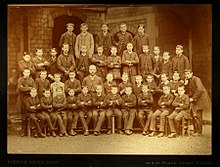
Cross-dressing is the act of wearing clothes traditionally or stereotypically associated with a different gender. From as early as pre-modern history, cross-dressing has been practiced in order to disguise, comfort, entertain, and express oneself.

A uniform is a variety of costume worn by members of an organization while usually participating in that organization's activity. Modern uniforms are most often worn by armed forces and paramilitary organizations such as police, emergency services, security guards, in some workplaces and schools, and by inmates in prisons. In some countries, some other officials also wear uniforms in their duties; such is the case of the Commissioned Corps of the United States Public Health Service or the French prefects. For some organizations, such as police, it may be illegal for non-members to wear the uniform.
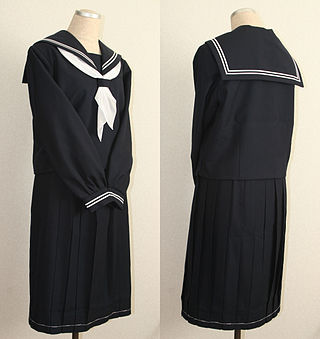
The Japanese school uniform is modeled in appearance similar to that of the European-style naval uniforms. It was first used in Japan in the late 19th century, replacing the traditional kimono. Today, school uniforms are common in many of the Japanese public and private school systems. The Japanese word for this type of uniform is seifuku (制服).
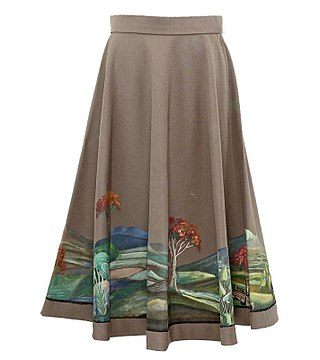
A skirt is the lower part of a dress or a separate outer garment that covers a person from the waist downwards.
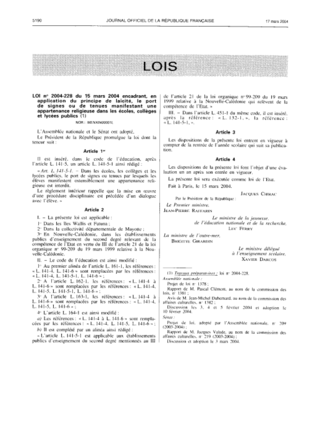
The French law on secularity and conspicuous religious symbols in schools bans wearing conspicuous religious symbols in French public primary and secondary schools. The law is an amendment to the French Code of Education that expands principles founded in existing French law, especially the constitutional requirement of laïcité: the separation of state and religious activities.

A dress code is a set of rules, often written, with regard to what clothing groups of people must wear. Dress codes are created out of social perceptions and norms, and vary based on purpose, circumstances, and occasions. Different societies and cultures are likely to have different dress codes, Western dress codes being a prominent example.
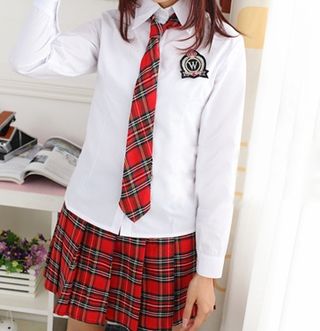
A Catholic school uniform in North America typically consists of a pleated and tartan skirt or jumper dress, Mary Jane or saddle shoes, a button-down shirt, and a sweater for girls, while boys' uniforms consist of a button-down shirt, a necktie, and dark pants. Actual school uniforms vary widely by location and individual school.
The Forney Independent School District is a school district based in Forney, Texas, United States.

Clothing fetishism or garment fetishism is a sexual fetish that revolves around a fixation upon a particular article or type of clothing, a particular fashion or uniform, or a person dressed in such a style.

Trousers or pants are a staple of historical and modern fashion. Throughout history, the role of trousers is a constant change for women. The first appearance of trousers in recorded history is among nomadic steppe-people in Western Europe. Steppe people were a group of nomads of various different ethnic groups that lived in the Eurasian grasslands. Archaeological evidence suggests that men and women alike wore trousers in that cultural context. However, for much of modern history, the use of trousers has been restricted to men. This norm was enforced in many regions due to social customs and laws. There are, however, many historical cases of women wearing trousers in defiance of these norms such as the 1850s women rights movement, comfort, freedom of movement, fashion, disguise, attempts to evade the gender pay gap, and attempts to establish an empowered public identity for women. Especially in the 20th and 21st centuries, the customs and laws restricting this manner of dress have relaxed dramatically, reflecting a growing acceptance and normalisation of the practice.

Various styles of head coverings, most notably the khimar, hijab, chador, niqab, paranja, yashmak, tudong, shayla, safseri, carşaf, haik, dupatta, boshiya and burqa, are worn by Muslim women around the world, where the practice varies from mandatory to optional or restricted in different majority Muslim and non-Muslim countries.

School uniforms in England are worn in over 90% of primary and secondary schools in England. Parents are required to purchase the uniform which in 2015 averaged roughly £212.88 per child.
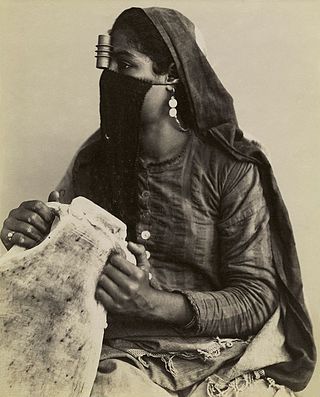
In a predominantly Muslim society, as many as 90% of women in Egypt have adopted a form of veiling. A majority of Egyptian women cover at least their hair with the hijab. A hijab refers to a head covering that is worn by Muslim women. Although the phenomenon of wearing the niqāb, a veil which covers the face is not as common, the niqab in Egypt has become more prevalent. While a few women in Egypt wear a black niqab along with a billowing black abaya as seen in countries such as Saudi Arabia, many choose to wear different colors of the niqab or manipulate the hijab to cover their face. Regardless, the growing trend of munaqqabat, or women who wear the niqab, has alarmed the authorities. They have begun to see this dress as a security threat, because it hides the face, and because it is perceived as a political statement, a rejection of the state in favor of a strict Islamic system.

Almost all South Korean secondary students wear a prescribed school uniform, gyobok. The majority of elementary schools except some private elementary schools do not have uniforms; however, the uniform is strictly enforced from the start of middle school and up. A typical South Korean uniform usually consists of a shirt, blazer and tie, with skirts for girls and trousers for boys. More recently, the uniform is often worn by celebrities who target the younger, teen audience to sell entertainment products. The school uniform and school setting is frequently used as a venue for romance. As a result, the uniform has become something akin to an expression of fashion among students.
The semiotics of dress is the study of design and customs associated with dress (clothing), as patterned to a kind of symbolism that has rules and norms. It describes how people use clothing and adornments to signify various cultural and societal positions.

School uniform is a practice that dates to the 16th century in England. Charity schools such Christ's Hospital, founded in 1552 in London, were among the first schools to use a uniform for their students. The earliest documented proof of institutionalised use of a standard academic dress dates back to 1222 when the Archbishop of Canterbury ordered wearing of the cappa clausa.
The Thai school uniform is compulsory for students in Thai public and private school systems, not including a higher education institute which provides degree level education. Few variations from the standard model are permitted, but schools are not restricted from adopting additional, non-standard uniforms. Most Thai schools have day per week where students wear either boy scout and girl guide uniforms to school, and partake in scouting activities in addition to regular classes. These uniforms are beige for boys and dark green for girls, both wearing neckerchiefs.

In Western society, since the 1960s, there has been a slow but steady trend towards bralessness among a number of women, especially millennials, who have expressed opposition to and are giving up wearing bras. In 2016, Allure magazine fashion director Rachael Wang wrote, "Going braless is as old as feminism, but it seems to be bubbling to the surface more recently as a direct response to Third Wave moments like #freethenipple hashtag campaign, increased trans-visibility like Caitlyn Jenner's Vanity Fair cover ... and Lena Dunham's show Girls."

Leg fetishism is a sexual interest that focuses on the legs, and is a type of partialism. In leg fetishism, individuals may experience a sexual attraction to the particular areas such as the thighs, knees, shins, calves or ankles.
At the beginning of February 2022, a dispute pertaining to school uniforms was reported in the Indian state of Karnataka, when some Muslim students of a junior college who wanted to wear hijab to classes were denied entry on the grounds that it was a violation of the college's uniform policy which was also followed by the other religion students as well. Over the following weeks, the dispute spread to other schools and colleges across the state, with groups of Hindu students staging counter-protests by demanding to wear saffron scarves. On 5 February, the Karnataka government issued an order stating that uniforms must be worn compulsorily where policies exist and no exception can be made for the wearing of the hijab. Several educational institutions cited this order and denied entry to Muslim girls wearing the hijab.



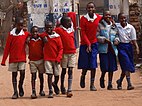




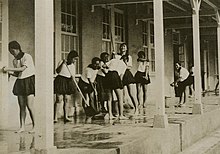








![Pupils in Taiwan 12.23 [Guo Li Tai Zhong Gao Ji Gong Ye Zhi Ye Xue Xiao ] Xue Sheng Ren Zhen Ting Zong Tong De Jiang Jie (31699754891).jpg](http://upload.wikimedia.org/wikipedia/commons/thumb/d/de/12.23_%E3%80%8C%E5%9C%8B%E7%AB%8B%E8%87%BA%E4%B8%AD%E9%AB%98%E7%B4%9A%E5%B7%A5%E6%A5%AD%E8%81%B7%E6%A5%AD%E5%AD%B8%E6%A0%A1%E3%80%8D%E5%AD%B8%E7%94%9F%E8%AA%8D%E7%9C%9F%E8%81%BD%E7%B8%BD%E7%B5%B1%E7%9A%84%E8%AC%9B%E8%A7%A3_%2831699754891%29.jpg/220px-12.23_%E3%80%8C%E5%9C%8B%E7%AB%8B%E8%87%BA%E4%B8%AD%E9%AB%98%E7%B4%9A%E5%B7%A5%E6%A5%AD%E8%81%B7%E6%A5%AD%E5%AD%B8%E6%A0%A1%E3%80%8D%E5%AD%B8%E7%94%9F%E8%AA%8D%E7%9C%9F%E8%81%BD%E7%B8%BD%E7%B5%B1%E7%9A%84%E8%AC%9B%E8%A7%A3_%2831699754891%29.jpg)





